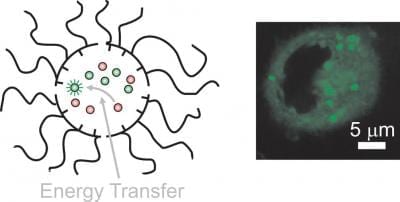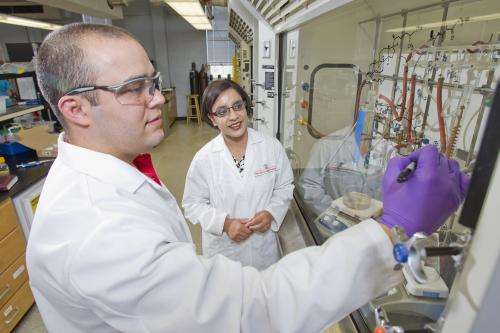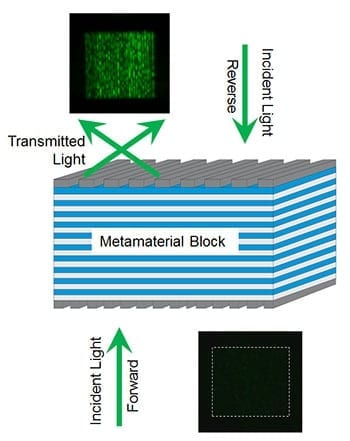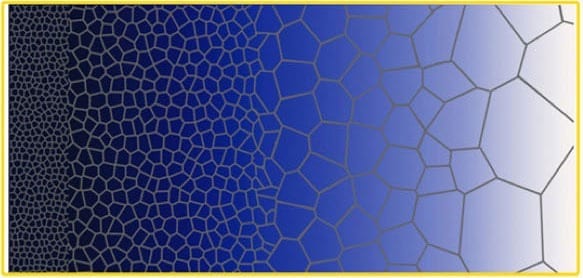
Researchers at the University of Miami and the University of Ulster have created nanoparticles that can transport interacting molecules into living cells.
With the continuing need for very small devices in therapeutic applications, there is a growing demand for the development of nanoparticles that can transport and deliver drugs to target cells in the human body.
Recently, researchers created nanoparticles that under the right conditions, self-assemble – trapping complementary guest molecules within their structure. Like tiny submarines, these versatile nanocarriers can navigate in the watery environment surrounding cells and transport their guest molecules through the membrane of living cells to sequentially deliver their cargo.
Although the transport of molecules inside cells with nanoparticles has been previously achieved using various methods, researchers have developed nanoparticles capable of delivering and exchanging complementary molecules. For practical applications, these nanocarriers are highly desirable, explains Francisco Raymo, professor of chemistry in the University of Miami College of Arts and Sciences and lead investigator of this project.
“The ability to deliver distinct species inside cells independently and force them to interact, exclusively in the intracellular environment, can evolve into a valuable strategy to activate drugs inside cells,” Raymo says.
Read more . . .
The Latest on: Nanocarriers
[google_news title=”” keyword=”Nanocarriers” num_posts=”10″ blurb_length=”0″ show_thumb=”left”]
via Google News
The Latest on: Nanocarriers
- A look at peptide products to protect against diseases and insectson May 13, 2024 at 5:23 am
Peptides are among the most-promising platforms for new biological-based products that protect horticulture and field crops against diseases and insect pests.
- Skin Care Newson May 9, 2024 at 4:59 pm
May 10, 2024 — Melanoma, an aggressive form of skin cancer that accounts for 75% of all skin-cancer-related deaths, is often detected later in people with darker skin complexions -- and the ...
- Eight Student Teams Named National Winners of 32nd Annual ExploraVision Competitionon May 7, 2024 at 6:10 am
The Toshiba/NSTA ExploraVision competition is designed to inspire students to develop the skills emphasized in the Next Generation Science Standards, including problem-solving, critical-thinking and ...
- Nanocarriers for Pulmonary Administration of Peptides and Therapeutic Proteinson May 5, 2024 at 10:33 pm
Nanocarriers may be an alternative way to overcome the problems of conventional formulations. Some nanocarrier-based formulations of peptides and therapeutic proteins are currently under development.
- Sydney researchers awarded over $42 million in NHMRC Investigator Grantson May 3, 2024 at 4:04 pm
The University of Sydney has been awarded over $42 million in 2024 NHMRC Investigator Grants funding to research some of the nation's greatest health challenges.University of Sydney researchers have ...
- Nanocarriers as an emerging platform for cancer therapyon April 14, 2024 at 10:23 pm
Several therapeutic nanocarriers have been approved for clinical use. However, to date, there are only a few clinically approved nanocarriers that incorporate molecules to selectively bind and ...
- Advanced Nanotechnology Leading the way to Cancer Imaging and Treatmenton April 7, 2024 at 12:47 am
Cancer remains a significant and debilitating disease, posing a formidable challenge to human health, and its incidence continues to rise steadily. The urgency to address this pressing issue has ...
- Selective nanoparticle adhesion can enhance colitis therapyon November 26, 2022 at 2:27 am
Although it is known that size has a major influence, the role of surface properties of nanocarriers in terms of adhesion to inflamed tissue remains unclear, even if preliminary studies indicate ...
- Nano Drug Carrier Research (IMAGE)on May 9, 2022 at 3:13 am
Millicent Sullivan (right) and graduate students Elizabeth Kelley and Ryan Murphy are part of a University of Delaware research team that has shown that routine processing and storage conditions ...
- The Daniel Heller Labon August 16, 2020 at 4:06 pm
D Tylawsky, H Kiguchi, J Vaynshteyn, J Gerwin, J Shah, T. Islam, J Boyer, D Boué, M Snuderl, M Greenblatt, Y Shamay, P Raju, DA Heller*, “P-selectin-targeted nanocarriers induce active crossing of the ...
via Bing News











